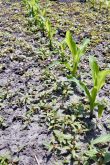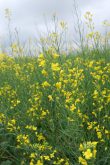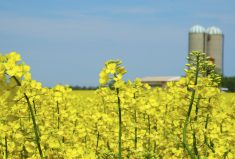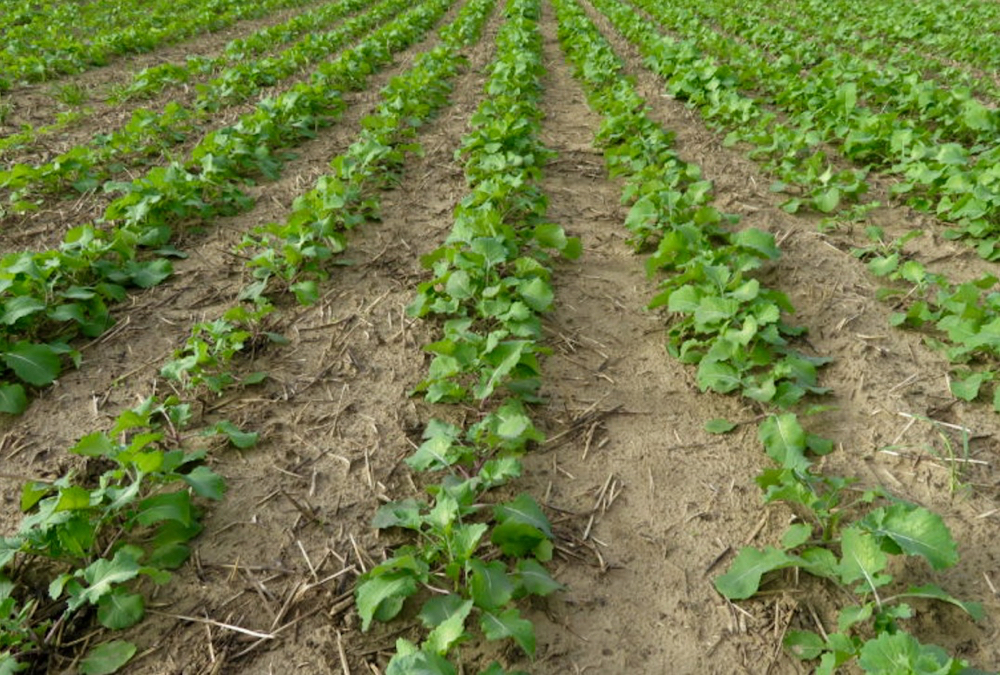Matt Kolkman is flabbergasted that he won the Ontario Canola Grower’s 2024 winter canola challenge.
Considering his first season was a comedy of errors with a punishing learning curve, Kolkman’s harvest was a Hollywood ending with a 5,066 pounds per acre yield growing Mercedes.
“I was just shooting from the hip the whole way through. There were three mistakes to every good thing, starting with planting,” said Kolkman during the Ontario Canola Growers Association’s annual general meeting. “I wasn’t even going to enter it, I thought, ‘This is not good.’”
Read Also
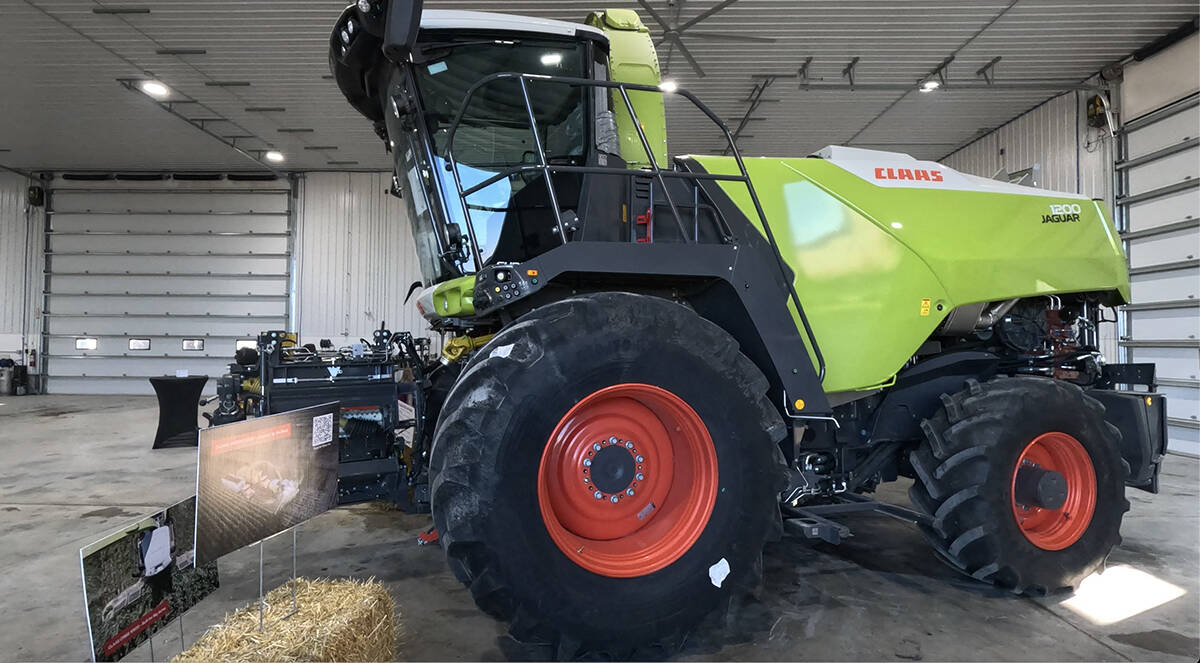
Claas brings 1000 Series SP forage harvesters to Canada
In mid-August, Claas unveiled its new line of Jaguar forage harvesters at an event in Visalia, California, deep in the heart of that state’s dairy region.
Why it matters: Winter canola is increasingly becoming a profitable rotation crop for farmers in southern Ontario.
The timing of winter canola aligns well with the family’s pig and cash crop operation, which focuses mainly on beans and corn for fall pig feed. It also effectively balances his workload, allowing him to prep the field with 40 units of N and one pass with a high-speed disc in the fall following winter wheat.
His goal was to seed at 2.5 lbs./acre with a 30-inch corn planter, doubling back to create 15-inch rows into Harriston loam at his Holstein-area farm. The monitor said planting was bang-on, but because the John Deere seed tubes couldn’t accurately meter canola seed, the rate was closer to 5.2 lbs./acre, cutting his projected acreage in half.
“We ended up having some solid seeded, some 15-inch rows and 30-inch rows in a field,” he admitted sheepishly. “I thought we were overseeded, but hearing what the other guys on the panel were saying, I wasn’t that far out, and I might have been light on the seeding rate if (the planter) was correct.”
On Apr. 25, Kolkman applied 180 pounds of nitrogen with Roundup and 250 ml/acre of Yuma pre-emerge to knock back volunteer wheat.
On May 18, at 95 per cent bloom, he sprayed Cotegra, a litre of boron and 34 ml/acre of Zivata to control potential white mould and cabbage seed weevil.
As harvest approached, Kolkman drove to Harrow to learn the best method for harvesting winter canola from Scott McLean, his dad and their custom operator.
“I learned more that whole day by just seeing it (done),” he said. “You want to set your machine up to do a good job, but nobody (around home) really has any experience with it.”
The seed rate might have been off, but strong seed growth resulted in a tall stand thanks to a good fall. Unfortunately, two days before they applied the pre-harvest spray on Jul. 17, a windstorm flattened about 40 per cent of one field but didn’t impact his competition acres. It nearly gave him a heart attack when he saw the damage.
He borrowed a canola auger from a buddy out west and ordered a Gordon sieve for his combine. However, the sieve was back-ordered and arrived weeks after the harvest wrapped.
“We did the down stuff first, and I’m like, ‘Oh, this isn’t looking too good.’ It was okay, but I could see the loss,” he said. “I couldn’t believe what the yield monitor was doing (on the challenge field). If it all would have stood, what kind of yield would we have had?”
This season, his canola will be planted on 15-inch rows with an air seeder at a slightly lower rate than the 5.2 lbs./acre. Kolkman is considering integrating a growth inhibitor to balance the nitrogen load and manage wind damage susceptibility.
Karl Neudorf of Harrow, who placed second with a 4,750 lbs./acre yield, considers himself a new winter canola grower with only five winter canola seasons under his belt. As a no-till farmer, Neudorf makes the exception for winter canola, tilling the sandy loam approximately four times to create an appropriate “garden-like bed” following his winter wheat crop.
One year, after an early bean harvest, he planted winter canola and was pleased by the clean bed, lack of volunteer winter wheat to deal with and mellow ground. He may consider it when planting winter canola on his Brookston clay fields.
Neudorf hired a custom planter to vacuum plant at three pounds/acre on 15-inch rows, but due to wet summer conditions, he couldn’t seed until Sept. 16.
“We don’t feel that’s ideal, but we are in the deep south as far as heat units, and the fall was on our side,” he said. “I would have liked to plant it two weeks earlier.”
He used 35 lbs. of nitrogen with some boron a week before planting, followed by 130 lbs. of nitrogen with sulphur in the spring.
Access to a good agronomist, an experienced custom planting operator, and advice from fellow producers have helped ease the learning curve.
“For me, farming is all about relationships, and even if I don’t know the best thing to do, I’ve got access to people that do,” said Neudorf. “I appreciate the advice, everything from agronomy to planting dates to just a sense of getting respect for that small seed that you have to be very careful planting.”
Thamesville’s Mark McKerral rounded out the top three with 4,692 lbs./acre.
Spring Canola
Long-time canola grower John Wiley of Meaford won the spring canola category with a 4,090 lbs./acre yield growing L350PC.
The 80-acre field was high-speed disced in the fall following corn with 200 pounds of potash broadcast.
“We have a 30-foot air drill, and when you buy the bigger bags, it seeds at 4.7 lbs./acre. That’s what I aim for,” Wiley said.
On Apr. 26, the field was high-speed disced and seeded with 35 gallons of UAN and five gallons of sulphur. Liberty was applied on Jun. 1 to deal with the minor lambs’ quarter population, followed by Proline on Jun. 20.
After a sweep net test showed above-threshold populations, Wiley sprayed for cabbage seedpod weevil. He’d planned to pre-harvest spray to even out the field, but wet weather and life got in the way, so it didn’t happen.
“We actually had a really good growing year with lots of moisture, so there was still lots of flower,” Wiley explained. “But the way it worked out, the field was completely ready by the time we were ready for harvest (in mid-August).”
He applied 120 lbs. of nitrogen, changing his management away from a blend in favour of UAN with nitrogen stabilizers application, which might have contributed to his high yield.
Kenilworth’s JR McLaughlin’s 3,708 lbs./acre yield of InVigor L340PC was strong enough to place second.
Speaking on behalf of McLaughlin, Harriston Agromart’s Jeff Jacques said the field had good background fertility, drainage and a fine disced and fall cultivated seed bed planted at 10 acres a bag.
“I was in that field first thing, and it was beautiful; the emergence was great,” Jacques said. “We were fairly conservative, I felt, on fertilizer and just ran 100 pounds of MESZ through the drill and did a pre-plant broadcast with 88 pounds of nitrogen and 58 pounds of potash. It was Aspire, so we got some boron in there.”
At bolting, they top-dressed Amidas granules and Coragen Max for swede midge.
“They’re just hard as bullets, these little granules, and you can fling them well,” Jacques said. “You don’t get dust, and the granules basically hit the leaves and then fall into the dirt.”
Proline and Microbolt boron at were applied at 15 per cent bloom for white mould and Roundup sprayed at pre-harvest to assist dry down.
“(JR) feels he has more than enough saved grain making it into the grain tank that more than pays for that pass,” said Jacques. “That crop had quite a bit more gas in the tank than what we saw, but after the tap turned off in July when the crop was flowering, there was a lot of heat blasting, and we gave up quite a bit of yield because of it.”
Simon Cloutier of Earlton secured third place with 3,351 lbs./acre of L340PC.




